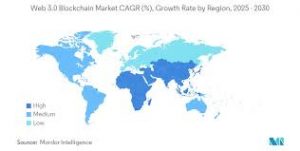As the internet continues to evolve from centralized platforms (Web2) to decentralized ecosystems (Web3), 2025 is shaping up to be a critical year in its mainstream adoption. With improved infrastructure, regulatory clarity, and stronger use cases, Web3 is no longer a buzzword—it’s becoming a real-world utility.

In this guide, we break down the top Web3 trends in 2025 and what to expect going forward.
🔍 What Is Web3?
Web3 refers to the next generation of the internet, built on blockchain and decentralized protocols. It allows users to own their data, interact with smart contracts, and use applications that don’t rely on centralized servers.
Key features of Web3:
-
Decentralization 🧩
-
Ownership through tokens & NFTs 🪙
-
Privacy-first systems 🔐
-
Interoperable digital identity 🆔
📈 Web3 Adoption Trends in 2025
1. ✅ Mainstream Brands Enter the Space
From Starbucks to Nike and Mastercard, more legacy companies are launching Web3 loyalty programs, NFT collections, and even metaverse stores.
Trend: Web3 integrations are now used to reward customers, offer exclusive access, and build digital communities.
Example: Starbucks Odyssey uses NFTs to reward customers for their loyalty.
2. 🪙 Web3 Payments and Wallets Go User-Friendly
2025 sees rapid progress in wallet UX, with tools like:
-
Account abstraction (smart contract wallets)
-
Gasless transactions
-
One-click logins using social or biometrics
These improvements are making it easier for non-technical users to use crypto wallets just like regular apps.
3. 🎮 Web3 Gaming Explodes
Game studios are moving beyond “Play-to-Earn” toward “Play-and-Own” models. Players can now truly own in-game assets (NFTs) and trade them across platforms.
Top projects gaining traction:
-
Illuvium
-
Big Time
-
Shrapnel
-
Parallel
Web3 gaming is set to rival traditional gaming in both quality and revenue models by 2026.
4. 🌍 Decentralized Identity (DID) Adoption Grows
Users are tired of giving personal info to every app. With decentralized identity systems, you can:
-
Log in without passwords
-
Own your credentials (education, health, skills)
-
Control who sees your data
Projects like ENS (Ethereum Name Service) and Polygon ID are leading the way.
5. 📚 Education & Employment Go On-Chain
2025 is seeing schools, universities, and companies issuing:
-
Blockchain certificates
-
NFT-based diplomas
-
Tokenized resumes
Web3 resumes let candidates prove qualifications instantly and reduce fraud in hiring.
6. 💼 Enterprise Adoption Picks Up
Fortune 500 companies are exploring private blockchains, supply chain tokenization, and Web3 governance models. Sectors like finance, health, and logistics are leading the adoption wave.
Examples:
-
IBM’s Hyperledger
-
JPMorgan’s Onyx blockchain
-
Walmart using blockchain for food traceability
7. 🏛️ Regulation Provides Clarity
In 2025, more than 20 countries have defined legal frameworks for:
-
Crypto trading
-
DAOs (Decentralized Autonomous Organizations)
-
Stablecoins
-
NFTs as digital property
Regulatory clarity is giving investors and developers the confidence to build in Web3 openly.
🧠 Key Challenges to Solve
-
UX complexity: Still harder to use than Web2 apps
-
Scalability: L2s and subnets helping, but mass adoption will test limits
-
Education gap: Many users still don’t understand wallets, gas fees, or DAOs
-
Scams & rug pulls: Risk still high without strong on-chain reputation systems
✅Web3 Is Maturing
2025 marks a shift from hype to utility in the Web3 space. With real use cases in gaming, finance, identity, and loyalty, adoption is growing faster than ever before. While challenges remain, the trend is clear:



